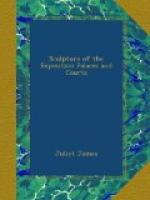Herman A. MacNeil was born in 1886, at Chelsea, Massachusetts. After graduating from the State Normal School of Massachusetts, he went to Paris, where he studied under Chapu of the Julian Academy, and two years under Falguiere of the Ecole des Beaux Arts. He came home and soon answered a call to Cornell, where he remained three years. Then three years were spent in teaching art at the Chicago Art Institute. While there, he taught Miss Carol Brooks of Chicago, whom he married in 1895. She is a very clever sculptor herself. Her “Listening to the Fairies,” “The First Wave,” “The First Lesson,” “Betty,” in the Fine Arts Palace of the Exposition, readily show how very charming her work is. Mr. and Mrs. MacNeil studied together in Rome for four years and on their return to America established themselves in New York, where the MacNeil studio is. He is the teacher of modeling of the National School of Design, New York. He has made a specialty of Indian subjects, “The Sun Vow,” “The Coming of the White Man,” and the “Moqui Runner” being some of his best pieces. To him the Indians are as fine as Greek warriors and most worthy of careful study. Whatever he does in sculpture is in its very essence national. He is extremely refined, a superb modeler and one whose every piece of work is strong and of the first rank.
Paul Manship
Standing quite apart from the other sculptors in his special joyous line of work is Paul Manship, a young man from St. Paul, Minnesota, born in 1885. He obtained the Prix de Rome from the American Academy, which prize allowed him to study in Rome and Greece for three years, from 1909 to 1912. His study in Greece gave a most interesting, individual touch to his work, for he united to his fresh, vigorous western style the classic precision of the Greek. He has a certain archaistic mannerism in his work recalling the Aeginetan marbles, which individuality puts a Manship stamp upon his work, striking a distinctly personal note. His statuettes are most charming and natural — little bursts of spirit and intense feeling. His work is always interesting — the kind you cannot pass by. He fills a niche all his own and is a most promising, gifted young sculptor. His “Spring Awakening” and “Playfulness” in the Twachtman Room of the Fine Arts Palace are delightfully exhilarating little figures.
Charles Niehaus
Charles Niehaus’ great talent lies in the lines of monumental sculpture. He was born in Cincinnati, in 1855. He was a pupil of the McMicken School of Art of that city, later attending the Royal Academy of Munich, Germany, where he took the first medal ever won by an American. He has won gold medals at the Pan-American Exposition, the Charleston Exposition and also at the Exposition of St. Louis. His work is of the extremely dignified order, and shows great simplicity of line. It is always the spirit of the work that claims you in all that he undertakes. He has done nothing finer than his “Garfield” at Cincinnati. His Astor Memorial Doors of Trinity Church, New York, his “Doctor Hahnemann” of Washington, D. C., and his “Driller,” symbolic of the energy of labor, are among his best works.




